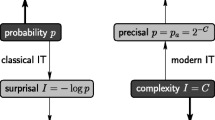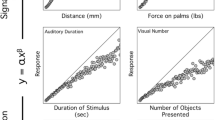Abstract
We explore experimental methods used to study the phenomena of perceptual organization, first studied by the Gestalt psychologists. We describe an application of traditional psychophysics to perceptual organization and offer alternative methods. Among these, we distinguish two approaches that use multistable stimuli: (1) phenomenological psychophysics, in which the observer's response is assumed to accurately and directly reflect perceptual experience; and (2) the interference paradigm, in which an observer's response is evaluated as correct or incorrect because it pertains to a corrigible task, but does not directly reflect the observer's experience. We show that phenomenological psychophysics can yield valuable information about perceptual organization and lends itself to the development of quantitative theory. We discuss some criticisms of the method and argue that the two approaches that use multistable stimuli are complementary. We also compare each of the approaches with traditional psychophysics. We conclude that the several methods are convergent.
Similar content being viewed by others
REFERENCES
Attneave, F.: 1968, 'Triangles as Ambiguous Figures', American Journal of Psychology 81, 447–453.
Bravais, A.: 1949, On the Systems formed by Points Regularly Distributed on a Plane or in Space, USA: Crystallographic Society of America (Original work published 1866).
Bregman, A.: 1990, Auditory Scene Analysis: The Perceptual Organization of Sound, Cambridge, MA: The MIT Press.
Brindley, G.S.: 1970, Physiology of the Retina and Visual Pathway, 2nd edn, USA: The Williams & Wilkins Company.
Fechner, G.: 1966, Elements of Psychophysics, Volume I, Holt, Rinehart and Winston, Inc. (Original work published 1860).
Geisler, W.S., T. Thornton, D.P. Gallogly, and J.S. Perry: 1999, 'Image Structure Models of Texture and Contour Visibility', Paper presented at RTO SCI Workshop on Search and Target Acquisition, held in Utrecht, The Netherlands, and published in RTO MP-45.
Hochberg, J. and D. Hardy: 1960, 'Brightness and Proximity Factors in Grouping', Perceptual and Motor Skills 10, 22.
Hochberg, J. and A. Silverstein: 1956, 'A Quantitative Index of Stimulus-Similarity: Proximity versus Differences in Brightness', American Journal of Psychology 69, 456–458.
Krantz, D.H., R.D. Luce, P. Suppes, and A. Tversky: 1971, Foundations of Measurement, Volume I, Additive and Polynomial Representations, NYC: Academic Press.
Kubovy, M.: 1994, 'The Perceptual Organization of Dot Lattices', Psychonomic Bulletin & Review 1(2), 182–190.
Kubovy, M., A.O. Holcombe, and J. Wagemans: 1998, 'On the Lawfulness of Grouping by Proximity', Cognitive Psychology 35(1), 71–98.
Kubovy, M. and J. Wagemans: 1995, 'Grouping by Proximity and Multistability in Dot Lattices: A Quantitative Gestalt Theory', Psychological Science 6(4): 225–234.
Kubovy, M. and S. Gepshtein: 2003, 'Perceptual Grouping in Space-time: An Exercise in Phenomenological Psychophysics', in R. Kimchi, M. Behrmann and C. Olson (eds.), Perceptual Organization in Vision: Behavioral and Natural Perspectives, Lawrence Erlbaum Associates, in press.
Kubovy, M. and D. Van Valkenburg: 2001, 'Auditory and Visual Objects', Cognition 80, 97–126.
Marr, D.: 1982, Vision, New York: W.H. Freeman.
Palmer, S.E.: 1980, 'What Makes Triangles Point: Local and Global Effects in Configurations of Ambiguous Triangles', Cognitive Psychology 12, 285–305.
Palmer, S.E. and N.M. Bucher: 1981, 'Configural Effects in Perceived Pointing of Ambiguous Triangles', Journal of Experimental Psychology: Human Perception and Performance, 7, 88–114.
Palmer, S.E. and N.M. Bucher: 1982, 'Textural Effects in Perceived Pointing of Ambiguous Triangles', Journal of Experimental Psychology: Human Perception and Performance 8, 693–708.
van Noorden, L.P.A.S.: 1975, Temporal Coherence in the Perception of Tone Sequences, Ph.D. thesis, Institute for Perceptual Research, Eindhoven, The Netherlands.
Wertheimer, M.: 1938, 'Laws of Organization in Perceptual Forms (1923)', In W. Ellis (ed.), A Source Book of Gestalt Psychology, London, UK: Routledge & Kegan Paul, pp. 71–88.
Rights and permissions
About this article
Cite this article
Strother, L., Van Valkenburg, D. & Kubovy, M. Toward a Psychophysics of Perceptual Organization Using Multistable Stimuli and Phenomenal Reports. Axiomathes 13, 283–302 (2003). https://doi.org/10.1023/B:AXIO.0000007207.77996.ca
Issue Date:
DOI: https://doi.org/10.1023/B:AXIO.0000007207.77996.ca




